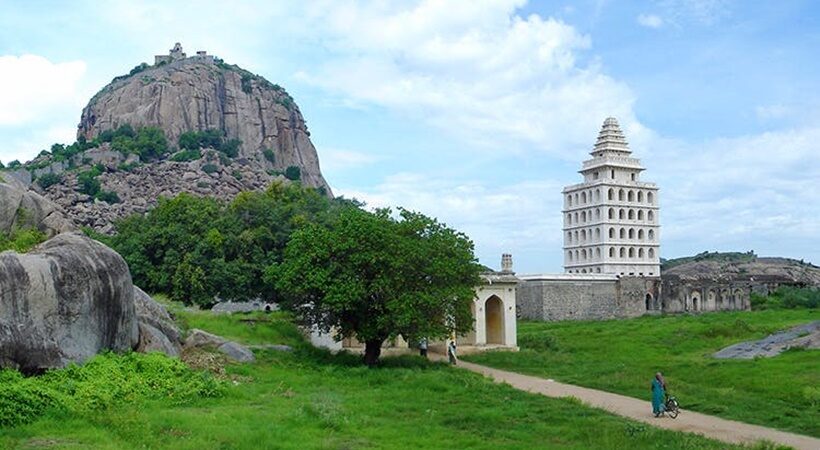The Ginjee or Senji Fort is located in Villupuram District of Tamil Nadu. One of the finest fort complexes in southern India, it was considered to be impregnable in peninsular India. In fact, it was the only fort that survived a Mughal siege for eight years, the longest one recorded in Mughal history. Its might and impenetrable nature have earned it the appellation of the “Troy of the East” from the English.
This fort has imbibed within itself layers of history and has witnessed the rise and fall of successive empires. During its history, spanning over centuries, it has been under the possession of several political powers of note such as the Vijayanagar Nayaks, the Bijapuri Sultans, the Mughals, the Marathas, the French and the English, and served as a strategic stronghold for each one of them.
A mere look at this formidable fortress, even today, allows one to comprehend the strategic significance of this structure. Built across three large hills and reinforced by fortifications and structures by successive rulers, this fortress developed into a nucleus of defence that powerful dynasties vied for control of.
The three hills: Rajagiri, Krishnagiri and Chandryandurg are encompassed by a large rampart, which is almost 60 feet wide, and a moat that is 80 feet in breadth. There also exists a smaller hill in the vicinity known as Chakkili Durg. The three main hills form a rough triangle and the rampart encloses an area of about 11 square kms which is known as the Lower Fort. The three hills contain individual citadels along with several other structures. The Lower Fort area also contains structures such as temples, mosques, pillared halls and tanks. Together they form the Gingee Fort complex.
The Rajagiri (also known as Anandagiri or Kamalagiri), which is almost 800 mts tall is the tallest of the three hills. The hill can be approached by a fortified path. One of the most significant features of the hill is a deep chasm (60 feet in depth) that separates it from the surrounding area. Access to the hill is controlled by a wooden bridge that lies over this deep fissure. The summit contains a citadel and the temple of Ranganatha whose sanctum is now empty. The Chandrayan Durg and Chakkili Durg are also believed to have been fortified at one point in time. However, today they mostly lay in ruins.
The beginnings of Gingee are shrouded in legends and mystery. Most historians believe that Gingee did not become a full-fledged fort until the 13th century. The first fortifications of note were built by Ananda Kon who was a political adventurer originally belonging to the shepherd community, at the beginning of the 13th century. Ananda Kon built a citadel on Kamalagiri (present Rajagiri) and renamed it Anandagiri. By the early 15th century, Gingee became one of the most important cities in South India.
The Vijayanagara empire was ruled by a three-tier system, with the emperor in Vijayanagara (Hampi); the nayakas or viceroys in Madurai, Gingee and Thanjavur; and the Polygars or chieftains at the local level. Thus, under the Vijayanagara rulers, it became the third city of the empire after Hampi and Madurai. It is the nayakas of Gingee, who strengthened the fort and built palaces and temples there.
Afterwards, the fort of Gingee has occupied a strategic place in historical developments in the Vijayanagara empire, the Bijapur sultanate, the Marathas and the Mughals. The fort finally lost its importance during British rule, as the fort was considered to be a hotbed of malaria. During the British and French wars for supremacy of the Tamil Nadu coast, the French conquered Gingee in 1750. For the 10 years that they held the fort, the French lost 1,200 soldiers to malaria. Due to this factor, the fort complex was abandoned and was taken over by the forest. Even today, despite the historical importance of the fort, it remains shrouded in mystery and has almost disappeared from public memory.



















